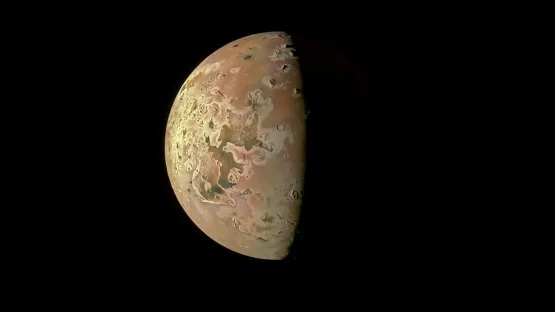
Volcanoes on Io Shed Light on Jupiter Moon's Interior Heat
2024-09-19
Introduction
Astronomers at Cornell University have delved into the tumultuous and fiery surface of Io, one of Jupiter's 95 moons, which boasts the title of the most volcanically active body in our solar system. This research provides valuable insights into a fascinating geological process known as tidal heating, crucial for understanding planetary formation and evolution.
Significance of Tidal Heating
“Tidal heating is vital for the thermal dynamics of celestial bodies,” stated Alex Hayes, the Jennifer and Albert Sohn Professor of Astronomy. “It provides the necessary warmth for the existence of subsurface oceans within moons orbiting gas giants like Jupiter and Saturn, potentially harboring conditions conducive to life.”
Research Findings
Lead author Madeline Pettine, a doctoral student in astronomy, emphasized that studying Io’s harsh and extreme landscape could guide scientists in their quest to find extraterrestrial life. The information gleaned from NASA’s Juno mission has been instrumental; the spacecraft’s flyby data revealed that active volcanoes concentrated at Io’s poles might play a crucial role in regulating the tidal heating process, which generates heat through friction within the moon's interior magma.
Detailed Analysis
Pettine explained the significance of her research, titled “JIRAM Observations of Volcanic Flux on Io: Distribution and Comparison to Tidal Heat Flow Models,” published in Geophysical Research Letters. By correlating observations from Juno with theoretical models, she identified a surprising trend: more active volcanoes are located at Io's poles rather than the more commonly active equatorial zones.
Geophysical Influence
“The gravitational pull from Jupiter exerts a strong influence on Io,” Pettine noted. “With gravitational interactions from Jupiter's other large moons, Io experiences constant stretching and compressing, which generates substantial internal heat.”
Methodology
Using spherical harmonic decomposition—a mathematical technique for analyzing round objects—Pettine was able to break down volcanic surface patterns on Io and compare these findings with existing theoretical frameworks, leading to intriguing conclusions about its geological processes.
Connections to Other Moons
While her research does not fully solve the mystery of tidal heating, Pettine connects her findings to icy moons in the outer solar system, like Jupiter's Europa and Saturn's Titan and Enceladus, which are also considered prime candidates in the search for alien life. These icy moons may have subsurface oceans sustained by tidal heating, making them potential hotspots for astrobiological exploration.
Implications for Astrobiology
“Understanding how heat is generated on these bodies is essential,” Pettine remarked, noting that studying a volcanic moon like Io is significantly more straightforward than analyzing ice-covered worlds where the heat may remain concealed beneath thick layers of ice.
Volcanic Activity Analysis
The study analyzed data from the Jovian Infrared Auroral Mapper (JIRAM) during 11 flybys of Io. Findings revealed that both polar regions host highly active volcanoes. In the north, a cluster of four volcanoes—Asis, Zal, Tonatiuh, and another unnamed volcano along with the well-known Loki—showed consistent high levels of activity. In the south, the volcanoes Kanehekili, Uta, and Laki-Oi exhibited strong volcanic behavior.
Synchronized Activity
Remarkably, the northern quartet of volcanoes demonstrated synchronized activity, brightening and dimming together, indicating a complex interplay between these explosive features. “It’s fascinating to observe how these volcanoes influence one another,” Pettine commented.
Research Collaboration
The collaborative research team also included Julie Rathbun, Samara Imbeah, and several other experts from institutions like the Jet Propulsion Laboratory. Funding was provided by NASA's New Frontiers Data Analysis Program and the New York Space Grant.
Conclusion
As scientific advancements continue to unveil the secrets of our solar system, Io’s volcanoes stand as a beacon of hope in the search for life beyond Earth, proving that even the most extreme environments may hold the key to understanding life's fundamental nature. Stay tuned for more discoveries that could redefine our knowledge of the cosmos!



 Brasil (PT)
Brasil (PT)
 Canada (EN)
Canada (EN)
 Chile (ES)
Chile (ES)
 España (ES)
España (ES)
 France (FR)
France (FR)
 Hong Kong (EN)
Hong Kong (EN)
 Italia (IT)
Italia (IT)
 日本 (JA)
日本 (JA)
 Magyarország (HU)
Magyarország (HU)
 Norge (NO)
Norge (NO)
 Polska (PL)
Polska (PL)
 Schweiz (DE)
Schweiz (DE)
 Singapore (EN)
Singapore (EN)
 Sverige (SV)
Sverige (SV)
 Suomi (FI)
Suomi (FI)
 Türkiye (TR)
Türkiye (TR)